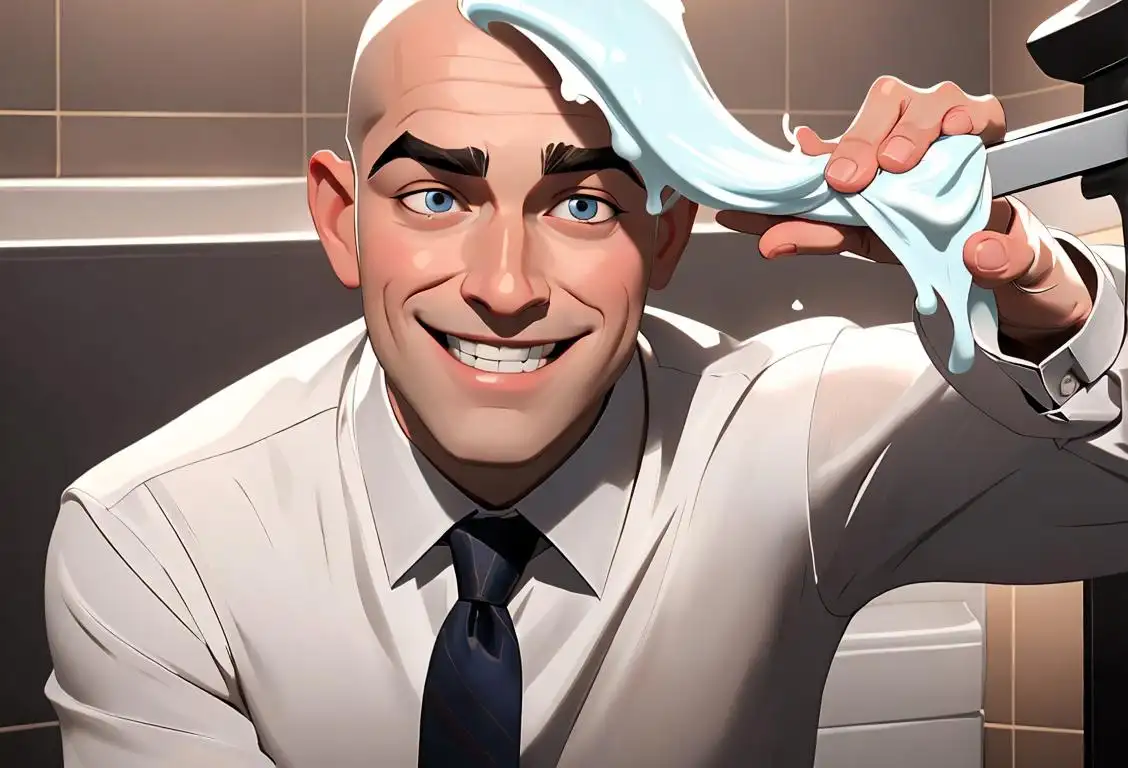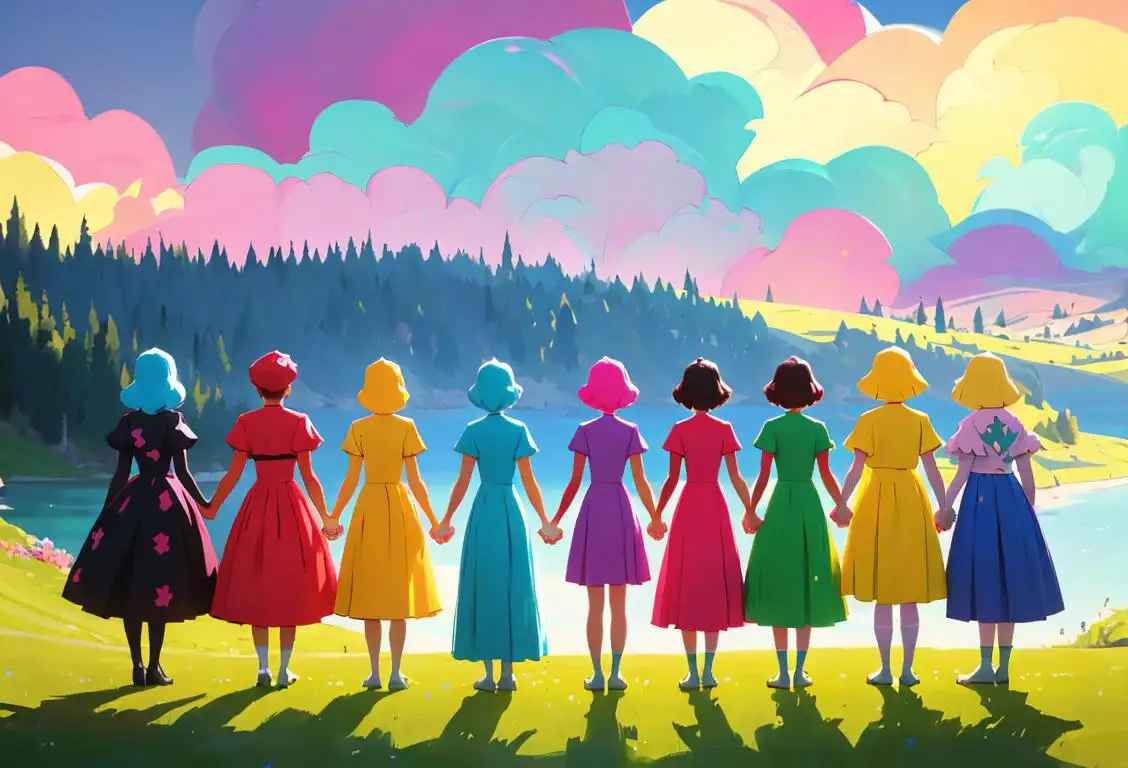National Shaving Day

Are you ready to get smooth and suave? It's time to celebrate National Shaving Day, a day dedicated to the art of hair removal in style. Whether you prefer a clean-shaven look or a perfectly shaped beard, this day is all about embracing the joy of grooming. So grab your razor and let's dive into the fascinating world of shaving!
When is Shaving Day?
It's national shaving day on the 13th February.
The Origins of National Shaving Day
While the exact origin of National Shaving Day remains a bit fuzzy, one thing is certain - people have been shaving since ancient times. Egyptians were known to use sharpened flint or bronze for a close shave, while Greeks and Romans favored scraping off their facial fuzz with shells and pumice stones. Fast forward to the 20th century, and shaving became a daily ritual for men around the world.
But why dedicate a whole day to shaving, you ask? Well, shaving not only helps keep our appearance neat and tidy, but it can also be a form of self-care and relaxation. So, it's only fitting to celebrate it with gusto!
Tips and Tricks for the Perfect Shave
Now, let's talk about the nitty-gritty of shaving. Whether you're a seasoned pro or just starting your grooming journey, these tips will help you achieve the perfect shave:
- Prep your skin: Take a warm shower before shaving to help soften the hair and open up your pores.
- Use a sharp razor: Dull blades can cause irritation and cuts, so make sure to use a fresh blade.
- Apply shaving cream: Choose a high-quality shaving cream or gel to provide lubrication and protect your skin.
- Go with the grain: Shave in the direction of hair growth to prevent ingrown hairs and irritation.
- Moisturize after shaving: Finish off with a gentle moisturizer to keep your skin hydrated and smooth.
Fun Fact: Shaving in the Movies
Did you know that shaving has played a prominent role in many famous movie scenes? From Tom Hanks in 'Cast Away' to Macaulay Culkin in 'Home Alone,' these moments have proved that shaving can be both hilarious and memorable. So, why not recreate your favorite movie shaving scene and have a good laugh?
History behind the term 'Shaving'
3000 BC
Early Beginnings
The history of shaving can be traced back to around 3000 BC, when ancient Egyptians were known for their sophisticated grooming habits. They used sharp flakes of flint or obsidian to shave their facial hair, maintaining a clean and smooth appearance. This practice was not only a personal preference but also had cultural and religious significance, as shaven faces were associated with cleanliness and hygiene in Egyptian society.
3000 BCE
The Beginnings of Shaving
Shaving can be traced back to ancient Egypt around 3000 BCE. The Egyptians were known for their elaborate grooming rituals, which included shaving. They used sharp flint or metal blades to remove their facial and body hair. Shaving was not only a hygienic practice for the Egyptians, but it was also considered a sign of social status and cleanliness.
3000 BC
Ancient Origins
Shaving can be traced back to ancient civilizations such as the Sumerians and Egyptians, who used sharp objects like flint or obsidian to remove unwanted hair from their bodies. In these early civilizations, shaving was primarily a way to maintain hygiene and prevent the spread of disease.
3000 BCE
Ancient Beginnings
Shaving can be traced back to ancient times when the concept of personal grooming first emerged. In ancient Egypt, it was considered a sign of cleanliness and wealth for both men and women to remove their body hair. They used seashells and pumice stones as makeshift razors to shave their heads and bodies.
3000 BC
The Origins of Shaving
Shaving can be traced back to ancient times, as early as the year 3000 BC. It is believed that the practice of shaving originated in ancient Mesopotamia, where men used sharpened obsidian or seashells to remove facial hair. The act of shaving was not only for personal grooming but also had symbolic and cultural significance in various civilizations.
3000 BCE
Early Shaving Techniques
In ancient Egypt, shaving was considered a mark of cleanliness and prestige. Men and women used flint blades or seashells to remove facial and body hair. Egyptian hieroglyphics dating back to this time depict men without beards and women with smooth, hairless bodies.
3000 BC
Ancient Beginnings
Shaving has ancient roots that date back to civilizations in ancient Mesopotamia and Egypt. Archaeological evidence suggests that both men and women in these ancient societies practiced shaving. Sharp flint blades or seashells were often used to remove unwanted hair from the face and body. For the ancient Egyptians, shaving had both practical and cultural significance, as it was believed to be a hygienic practice and was also associated with cleanliness and beauty.
3000 BC
The Ancient Egyptians and Sumerians
Shaving can be traced back to the ancient civilizations of Egypt and Mesopotamia. Both the Egyptians and Sumerians practiced the art of shaving, using primitive tools like shells, pumice stones, and flint blades. They believed that shaving not only kept them clean but also offered protection against lice and parasites. Shaving was primarily a grooming practice for the wealthy and elite.
3000 BC
Early Origins
Early depictions of ancient Egyptians shaving their facial hair can be found on cave paintings dating back to 3000 BC. They used sharpened flint or seashells as primitive razors, scraping away their hair as a way to stay clean and hygienic in the hot Egyptian climate.
3300 BC
Ancient Origins
Archaeological evidence suggests that the practice of shaving dates back to ancient civilizations like Egypt and Mesopotamia. In 3300 BC, ancient Egyptians used sharpened flint or bronze razors to remove facial hair. They believed that a smooth face was a symbol of cleanliness and high social status.
500 BCE
Roman Innovations
The Romans took shaving to the next level by inventing the first proper shaving tool, the straight razor. They believed that a clean-shaven face was a symbol of nobility and distinction. The straight razor consisted of a sharp blade made of iron or bronze that allowed for a more precise shaving experience.
500 BCE
The Rise of Razors
Greek barbers introduced the first razors made from iron or bronze. These rudimentary razors had a single blade and were typically used by professional barbers to groom their clients. Shaving became a regular part of Greek culture, with men embracing the smooth look.
500 BC
Egyptian Innovations
In the year 500 BC, the ancient Egyptians took shaving to a whole new level. They developed intricate copper or gold razors and even created specific shaving chambers in their temples. Shaving for Egyptians had a religious aspect, as it symbolized cleanliness and purity.
4th Century BC
The Greek Influence
The ancient Greeks placed a high importance on physical beauty, which extended to removing body hair. Shaving became more widespread among men in Greek society, especially among athletes who wanted to showcase their physical prowess during the Olympic Games. Greek sculptures and artwork from this period often depicted men with clean-shaven faces and smooth bodies.
1760 BCE
Metal Razors in Mesopotamia
In Mesopotamia, around 1760 BCE, metal razors made their appearance. These razors were typically made of copper or bronze and had decorated handles, reflecting the importance of grooming in their culture. The use of metal razors made shaving a smoother and more efficient process.
4th Century BC
Greek and Roman Influences
During the Greek and Roman eras, shaving took on a more aesthetic purpose. Beards and facial hair were seen as symbols of wildness and barbarism, so shaving became popular among the upper class. The Greeks even introduced the use of more sophisticated tools like bronze razors with detachable blades.
500 BC
Greek Influence
In ancient Greece, shaving was not only a grooming ritual but also a symbol of masculinity. The desire for smooth and youthful-looking skin led Greek men to develop a variety of shaving techniques. They were known to use a bronze or iron razor, which was manufactured by local blacksmiths. The concept of shaving spread throughout the Greek empire and became an integral part of their culture.
500 BC
Rise of Greek Civilization
In ancient Greece, the athletic ideal prompted men to remove their body hair, including facial hair. They used a method called plucking, using tweezers or by tying thread around the hair and pulling it out. This practice was not only aesthetically pleasing but also practical for soldiers and athletes, as it prevented their opponents from having a grip during physical combat.
300 BC
Greek Influence
Around 300 BC, the Greeks introduced the concept of personal grooming and hygiene. They considered body hair to be uncivilized and unattractive, so shaving became a common practice among Greek men. They used a variety of tools like iron razors, shells, and even pumice stones to achieve a clean-shaven look.
500 BC
Razor Revolution
The development of metalworking techniques brought about a significant change in the history of shaving. Around 500 BC, the ancient Greeks and Romans began using metal razors made from copper or iron. These early razors featured a straight blade that was sharpened on both sides. They were primarily used by men to maintain a groomed appearance, as beards were considered a symbol of virility and masculinity.
Middle Ages
Beards Make a Comeback
In contrast to the ancient Greeks and Romans, the Middle Ages saw a resurgence in the popularity of beards. Beards were considered a symbol of masculinity and wisdom, and shaving became less common during this period. However, men still trimmed their beards with scissors or combs to maintain a neat appearance.
1760 AD
The Rise of the Straight Razor
During the 18th century, shaving saw a major transformation with the introduction of the straight razor. It was invented in Sheffield, England, which became known as the 'Steel City' due to its production of high-quality steel blades. The straight razor quickly gained popularity among men as it provided a closer shave compared to previous shaving tools. Barbershops became prevalent during this period, offering professional shaving services using the newly developed straight razor.
1762
Safety Razor Invention
The invention of the safety razor in 1762 by Frenchman Jean-Jacques Perret marked a major milestone in shaving history. Perret's design featured a razor with a protective guard, which helped reduce the risk of accidental cuts and made shaving a safer and more accessible practice. This innovation paved the way for the mass production of affordable safety razors and made regular shaving more feasible for people of all backgrounds.
1096 AD
Introduction of the Straight Razor
The Crusaders, upon returning to Europe from the Middle East, brought with them the straight razor, also known as the cut-throat razor. This tool revolutionized shaving techniques, offering a more precise and efficient way to remove facial hair. These razors were initially used exclusively by professional barbers.
1st Century BC
Roman Influence
The Romans adopted shaving as a cultural norm during the 1st century BC. They believed that a clean-shaven face reflected discipline and masculinity. Roman men used professional barbers called tonsors, who provided shaving services using sharp razors and specialized creams.
1760
The Birth of the Safety Razor
In 1760, French barber Jean-Jacques Perret invented the world's first safety razor. It featured a protective guard to prevent accidental cuts. This design paved the way for future developments in shaving technology and made the act of shaving safer and more accessible.
2nd Century AD
Roman Influence
During the 2nd century AD, the Romans popularized the practice of shaving across their vast empire. Roman men would visit barbers called "tonsors" who would use bronze or iron razors to provide clean shaves. This period also saw the rise of the famous Roman Emperor, Hadrian, who was known for his cleanly shaved face.
1750 CE
Rise of Shaving Brushes
During the 18th century, shaving brushes made from animal hair started to gain popularity. These brushes were used to lather up soap or cream before applying it to the face, making the shaving experience more comfortable and efficient. The use of shaving brushes became an essential part of men's grooming routines.
1st Century BC
The Rise of the Roman Empire
Shaving gained further popularity during the Roman Empire. Roman men preferred a clean-shaven look and considered beards as a symbol of barbarism. Emperors like Julius Caesar and Augustus set a trend by sporting well-groomed faces, inspiring men throughout the empire to follow suit. Roman barbershops became social hubs where men gathered to discuss politics and engage in grooming rituals.
6th Century BCE
Greek Influence on Shaving
The ancient Greeks valued a clean-shaven appearance and smooth skin. Around the 6th century BCE, they adopted the practice of shaving and made significant advancements in the field. Greeks introduced the concept of using shaving creams and oils to soften the hair and protect the skin. They also developed different styles of beards and mustaches, which were seen as a symbol of masculinity and sophistication.
1901 CE
Safety Razor Revolution
In 1901, King C. Gillette invented the modern safety razor, revolutionizing the art of shaving. This new razor design featured a replaceable blade and a protective guard, significantly reducing the risk of cuts and making shaving more accessible to the masses. The safety razor quickly became a household item, transforming men's grooming habits worldwide.
1581
The Birth of the Straight Razor
The modern straight razor, also known as the cut-throat razor, was invented in Sheffield, England, in 1581. This innovation allowed for a more controlled and precise shaving experience. The straight razor became immensely popular throughout Europe and remained the primary tool for shaving until the 19th century.
17th Century
The Arrival of the Safety Razor
The concept of a disposable safety razor was introduced in the 17th century. The design evolved over time, but the basic principle of a sharp blade protected by a guard remained the same. This innovation made shaving more accessible and less risky, as it minimized the chances of accidental cuts and injuries. Safety razors marked a significant milestone in the history of shaving.
18th Century
The Birth of the Straight Razor
In the 18th century, a new invention revolutionized shaving: the straight razor. This type of razor featured a foldable blade that could be sharpened and used repeatedly. It provided a more precise and comfortable shaving experience compared to previous tools. The straight razor became a staple in barbershops and among those who could afford it.
1880s AD
Safety Razor Invention
The invention of the safety razor in the 1880s revolutionized shaving for the masses. It eliminated the need for professional barbers and allowed individuals to shave in the comfort of their own homes. Safety razors featured a protective guard that reduced the risk of cuts and made shaving more accessible to a wider population. This innovation marked a significant shift towards personal grooming and self-care.
9th Century
Medieval Period
During the medieval period, facial hair regained popularity among European men. Beards became a symbol of power, wisdom, and masculinity. However, shaving still remained popular among the upper class, who used various shaving tools like razors made of iron, bronze, or ivory, along with oils, creams, and strops.
18th Century
Invention of the Modern Straight Razor
The 18th century brought about significant advancements in shaving technology. The modern straight razor, with a sharp, foldable blade, was invented in Sheffield, England. This innovation revolutionized the shaving experience, making it more convenient and efficient.
1901
King C. Gillette's Innovation
King C. Gillette, an American businessman, introduced the disposable safety razor in 1901. This groundbreaking invention featured a thin, replaceable blade that made shaving more convenient and affordable for the masses. It revolutionized the industry and established Gillette as a prominent name in shaving.
1762
The Invention of the Safety Razor
French barber Jean-Jacques Perret invented the first safety razor, which had a protective guard along the edge, reducing the risk of cuts and nicks. This innovation made shaving safer and more accessible for individuals to perform at home. It marked a turning point in the history of shaving, leading to the mass production and adoption of safety razors worldwide.
1901
King Camp Gillette and Disposable Blades
In 1901, American businessman King Camp Gillette introduced the world's first disposable blade razor. His invention featured a double-edged blade that could be easily replaced, eliminating the need for sharpening or stropping. This innovation revolutionized the shaving industry and made shaving more convenient and affordable for the masses. Gillette's company eventually became one of the leading manufacturers of shaving products worldwide.
1901
The Birth of Disposable Razors
American inventor King C. Gillette introduced the first disposable razor, featuring a replaceable blade. This invention made shaving even more convenient and economical, as individuals could simply dispose of the entire razor instead of sharpening or replacing only the blade. Disposable razors quickly gained popularity and became a staple in millions of bathrooms worldwide.
20th Century
Safety Razors and Electric Shavers
In the early 1900s, safety razors were introduced, featuring a protective guard to reduce the risk of cuts. This made shaving more accessible to the general population. Later in the century, electric shavers emerged, offering a convenient and fast alternative to traditional shaving methods.
17th Century
Rise of the Straight Razor
In the 17th century, the invention of the straight razor revolutionized the shaving experience. William Hallowes, a manufacturer from Sheffield, England, designed the first modern straight razor with a folding handle, making it easier to carry. Straight razors quickly gained popularity and became the standard tool for shaving.
20th Century
Safety Razors and Electric Shavers
The 20th century brought two significant advancements in shaving technology. In 1901, King C. Gillette patented the first safety razor, which featured a disposable blade, making shaving more accessible and convenient. Later, in the 1930s, electric shavers were introduced, offering an alternative to traditional wet shaving methods. Electric shavers rapidly gained popularity for their efficiency and ease of use.
1960s
The Electric Shaver Emerges
In the 1960s, electric shavers gained popularity with the introduction of reliable and efficient models. Electric shavers offered a faster and more convenient alternative to traditional wet shaving. They quickly became a preferred choice for many, especially those seeking a quick shave on-the-go.
20th Century
Electric Shavers and Disposable Razors
The 20th century brought forth two major advancements in shaving technology. In the 1920s, Jacob Schick invented the electric shaver, which revolutionized the industry by offering a convenient alternative to traditional manual razors. Later, in the mid-20th century, the introduction of disposable razors made shaving even more convenient for individuals on the go. These innovations made shaving a quick and hassle-free task.
1970 CE
Electric Shavers
The introduction of electric shavers in the 1970s provided an alternative to traditional wet shaving. Electric shavers offered convenience and speed, allowing for dry shaving without the need for lather or water. This innovation provided individuals with a quick and efficient shaving solution, especially for those with busy lifestyles.
1971 AD
Introduction of Electric Shavers
The year 1971 saw the introduction of the first commercially successful electric shaver. The Philips Norelco (known as Philips Philishave in Europe) revolutionized the shaving industry by offering a convenient and faster alternative to traditional wet shaving. Electric shavers became popular among men who preferred a quick and effortless shaving experience, and they continue to be a popular choice to this day.
1847
Safety Razors for Masses
In 1847, William Henson patented the first safety razor design. This invention revolutionized the shaving experience by incorporating a protective guard to minimize the risk of cuts and nicks. Safety razors made shaving more accessible and safer for the general population, and their popularity soared.
1960s
Electric Shavers Gain Popularity
The 1960s witnessed the rise of electric shavers as a popular alternative to traditional manual razors. Electric shavers offered the convenience of quick and effortless shaving, attracting a significant number of men who sought a more efficient way to groom themselves. The introduction of rotary and foil shavers by companies like Philips and Remington further diversified the market, giving consumers a range of options to choose from.
Present Day
Shaving as Personal Choice
Today, shaving has become a personal choice rather than a societal norm. Some men prefer to maintain a clean-shaven look, while others embrace facial hair in various styles. With advancements in shaving products and techniques, individuals have more options than ever to express their grooming preferences.
1762
Birth of the Safety Razor
The safety razor, a pivotal development in shaving history, was invented by Jean-Jacques Perret in France in 1762. This razor featured a protective guard to reduce the risk of cuts and was the precursor to the modern safety razors we use today. It marked a significant improvement in shaving safety and accessibility.
21st Century
Evolution of Shaving Technology
In the 21st century, the art of shaving has continued to evolve with advancements in technology. Companies have introduced innovative features in razors such as multiple blades, lubricating strips, and pivoting heads to enhance the shaving experience. Additionally, the concept of facial grooming has expanded beyond traditional shaving, with the popularity of grooming styles like stubble, beards, and mustaches. Today, shaving products cater to a diverse range of preferences, allowing individuals to express their personal style through their facial hair.
2000s
Shaving in the Digital Age
With the advent of the internet and digital marketing, the shaving industry witnessed significant changes. Online subscription services, such as Dollar Shave Club, disrupted the market by offering affordable razor subscriptions delivered directly to consumers' doors. These services embraced a direct-to-consumer model, challenging traditional brick-and-mortar retail.
Present
Modern Shaving Trends
In the present day, shaving has become a personal choice influenced by individual preferences and cultural trends. While many men still opt for the traditional wet shave using safety razors or disposable razors, there has been a resurgence of beards and facial hair in recent years. The rise of grooming and skincare products specifically catering to men reflects the evolving landscape of personal care and the desire for self-expression. With the advent of technology, advancements in shaving tools and techniques are continuously being developed to enhance the shaving experience.
1971
Electric Shavers Take the Stage
The introduction of the first commercially successful electric shaver by Philips Norelco revolutionized the shaving industry. Electric shavers provided a convenient alternative to traditional manual shaving, offering a quick and efficient way to remove facial hair. They continue to evolve with new technologies, becoming a popular choice for many individuals.
Present Day
Shaving in the Modern World
Today, shaving has evolved into a widespread practice embraced by people worldwide. With the advent of multi-blade razors, shaving creams, and aftershaves, the art of shaving has become not only a daily grooming routine but also a form of self-expression. Additionally, trends like beards and facial hair styles have also influenced the way people approach shaving, with specialized tools and products catering to diverse grooming preferences.
Present Day
Shaving as a Personal Choice
In modern times, the practice of shaving has evolved into a personal choice. While some individuals embrace a clean-shaven look, others prefer to maintain facial hair or experiment with various styles and trends. The availability of a wide range of shaving products, from traditional straight razors to modern multi-blade cartridges, caters to the diverse preferences of individuals when it comes to grooming and personal style.
Present
Shaving Innovations and Trends
In recent years, the world of shaving has seen numerous innovations and trends. From multi-blade cartridge razors to precision trimmers and subscription-based shaving clubs, there is a wide range of products and services catering to individual preferences. Additionally, the resurgence of beard culture has led to the popularity of beard grooming products, such as beard oils and balms.
1901
Disposable Razor Revolution
King Camp Gillette introduced the world's first disposable razor in 1901. This razor featured a replaceable and disposable blade, eliminating the need for regular sharpening. The disposable razor gained widespread popularity due to its convenience and affordability, making shaving a simpler task for many individuals.
1971
Introduction of Electric Shavers
The Philips company introduced the first commercially successful electric shaver in 1939, but it wasn't until 1971 that Remington released its cordless electric shaver, which truly transformed the shaving industry. Electric shavers offered a quick and efficient alternative to traditional razors, and they continue to be a popular choice for many people worldwide.
1901
The Disposable Razor
The King C. Gillette Company introduced disposable razors in 1901, forever changing the shaving industry. These razors featured replaceable blades, eliminating the need for sharpening and providing a convenient and affordable shaving option for the masses. The disposable razor became a game-changer in terms of accessibility and convenience.
20th Century
Electric Shavers
The 20th century saw the rise of electric shavers, offering a new and efficient way to achieve a clean shave. In 1928, Colonel Jacob Schick invented the first electric dry shaver, paving the way for modern electric shavers. The introduction of electric shavers provided men with an alternative to traditional wet shaving methods.
Present
Continuing Evolution
Shaving has come a long way, and it continues to evolve with advancements in technology and grooming preferences. Today, we have a wide range of options, including multi-blade razors, safety razors, electric shavers, and even laser hair removal. Personal grooming habits have become diverse, catering to individual styles and preferences.
Did you know?
Did you know that the average man will spend around 5 months of his life shaving?Tagged
fun self-care groomingFirst identified
13th February 2020Most mentioned on
13th February 2020Total mentions
18Other days
Shaving Day
Everything You Do Is Right Day
Lash Day
Self Care Day
Healing Day
Grooming Day
Appreciate Yaself A Lil Extra Day
Mental Health Day
I Forgot Day
Break Up With Your Girlfriend Day








